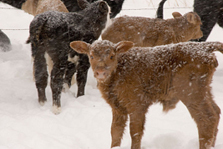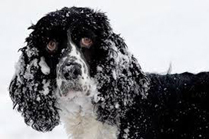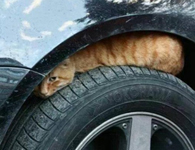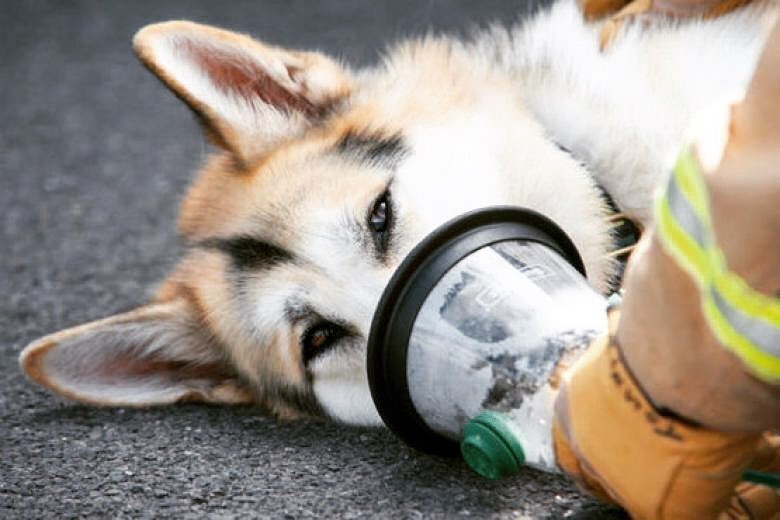
Unfortunately many people think since animals have fur or thick hide they are able to withstand the cold better than humans, but often this is not the case. Cold weather can be as hard on critters as it is on people and may lead to serious illness, injury or death.
Gimme shelter: When the temperatures drop in the winter months, bring your pets and critters indoors since they can be susceptible to frostbite and hypothermia. If you don’t have a barn or structure for livestock and other outdoor animals, at least make some type of windbreak to help keep them safe and out of the wind.
If you do keep livestock indoors, make sure the barn / building is well ventilated since ammonia can build up. Also add plenty of dry bedding (such as straw) to stalls, coops and cages so animals aren’t standing or lying on the cold ground, and provide a blanket for pets to sleep on. Space heaters and heat lamps should be avoided because of the risk of burns or fire. Heated pet mats should also be used with caution because they are still capable of causing burns.
Water and food: Make sure pets and livestock have plenty of fresh food and water, and constantly check their bowls and troughs to ensure their water isn’t frozen. Increase feed amounts for pets and livestock during cold snaps since they’ll burn more calories trying to keep warm. Also try to keep at least several weeks worth of feed on hand since you don’t want to run out when it may be difficult to have another load delivered.
Watch for signs: Take extra time to observe livestock, looking for early signs of disease and injury. Ready.gov explains severe cold-weather injuries or death primarily occur in the very young or in animals that are already debilitated. Cases of weather-related sudden death in calves often result when cattle are suffering from undetected infection, particularly pneumonia. Sudden, unexplained livestock deaths and illnesses should be investigated quickly so that a cause can be identified and steps can be taken to protect the remaining animals.

Animals suffering from frostbite don’t exhibit pain. It may be up to two weeks before the injury becomes evident as the damaged tissue starts to slough away. At that point, the injury should be treated as an open wound and a veterinarian should be consulted.
Your pets will give you signs too. If it is whining, shivering, seems anxious, slows down or stops moving, seems weak, or starts looking for warm places to burrow, get them back inside quickly because they are showing signs of hypothermia.
Also, the AVMA suggests you check your dog’s paws frequently for signs of cold-weather injury or damage, such as cracked paw pads or bleeding. During a walk, a sudden lameness may be due to an injury or may be due to ice accumulation between his/her toes. You may be able to reduce the chance of iceball accumulation by clipping the hair between your dog’s toes.
According to the American Animal Hospital Association…
- Frostbite happens when an animal’s (or person’s) body gets so cold it pulls all the blood from extremities to the body’s core to stay warm. An animal’s ears, paws, and tail can get so cold that ice crystals form in the tissue damaging it. Frostbite can be tricky because it is not immediately obvious. Sometimes the tissue doesn’t show signs of damage for several days. If you suspect your pet may have frostbite, contact your veterinarian immediately.
- Hypothermia is body temperature that is below normal. This condition occurs when an animal is unable to keep its body temperature from falling below normal. It occurs when an animal spends too much time in cold temperatures, or when an animal with poor health or circulation is exposed to cold. In mild cases, the animal will shiver and show signs of depression, lethargy, and weakness. As the condition progresses, muscles will stiffen, the heart and breathing rates slow, and the animal will stop responding to stimuli.

Cat check: Outdoor and feral cats have a tendency to curl up against a warm vehicle engine during cold spells so check beneath your car, bang on the hood, and honk the horn before starting the engine to scare the critters away.
Hoof check: If you have hooved livestock, hoof care is very important during winter months since wet ground combined with dirty conditions (esp. bacteria and fungi) may cause thrush and foot rot. Robyn Scherer (author of “Managing Livestock in Winter Conditions” article in Countryside magazine) explains regular trimmings should be performed to keep feet in good condition. Also, if you own horses in cold country, pick their feet on a regular basis to prevent ice balls from forming, as this can cause stress on tendons and ligaments.
Antifreeze: It only takes a few tablespoons of highly toxic antifreeze to seriously jeopardize an animal’s life. Ethylene glycol, the most common ingredient in antifreeze, can cause crystals to form in an animal’s kidney, ultimately leading to kidney failure and death.

Holiday food and decorations: Avoid giving your pets rich, fatty foods like ham, turkey or goose since they can cause stomach problems, plus bones can splinter easily. And keep toxic foods such as onions, grapes, raisins, xylitol (a sugar substitute) and chocolate away from dogs, as well as plants like poinsettia, holly and mistletoe.
Dogs – esp. puppies – like to chew and eat anything … and cats love to play with shiny, dangly things so keep an eye on decorative strings of lights (both indoors and out) as well as ribbons, tinsel, ornaments and candles.
Heaters: Check your furnace to make sure it’s working efficiently, and install (and test) carbon monoxide detectors to keep your pets and family safe. Carbon monoxide is odorless and invisible, but it can cause problems ranging from headaches and fatigue to trouble breathing to even death. Also use space heaters with caution since they can burn your pets or the units can be knocked over, potentially starting a fire.
Move it: Exercise is good for pets, livestock and humans during the long winter months, but just make sure you don’t overdo it in the chilly temps and watch for signs of frostbite or hypothermia (see above). Also make sure you wipe down pet’s paws after playing or walking outside to remove any ice chunks or salt that may have gotten wedged in their pads or between their toes.
Be prepared: Cold weather
also brings the risks of severe storms, blizzards, tornadoes and power
outages. Create disaster supplies kits for your home and vehicles and
don’t forget to pack supplies and water for your critters too.
Download
a free 68-page ebook compliments of Fedhealth and USFRA to help your family and others get prepared.


